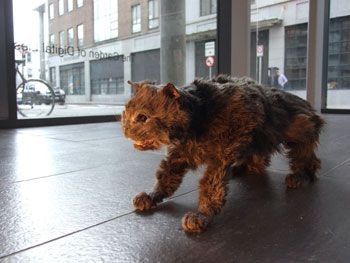 |
Kurt Bear Koss: The Gospel of Thomas, 2005; courtesy the artist |
You walk past the building and you’ll be most tempted to go in; there is a dead cat on the floor, its back arched in reaction to…
1. Now: the light, which shines in its face.
and
2. Then: The last thing it saw on that fateful day it stopped being a cat and began its journey into art-hood.
Of course the cat moves, for this is no ordinary dead animal in a gallery, as this purports to be no ordinary group show. This piece is curator K Bear Koss’ contribution to the exhibition. Behind the cat, neatly printed onto the wall in large grey type, is a quote from the Gospel of Thomas, something that is in itself both ancient and new; like this show, it says “okay, here’s some art, I’m going to assume you’ve seen that before, now watch it done differently." On its own it could be said that the work lacks a bit of meat, but in the context of the show itself, the curator – who describes himself as a “cheerleader for artists whose work I like" – provides an excellent starter for the main course.
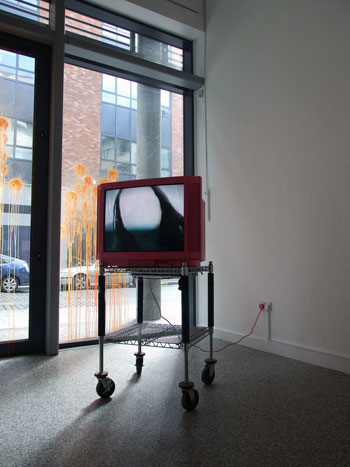 |
Alan Butler: Beyond sex and death, 2008; courtesy the artist |
The first artwork (dead cat aside) you meet on entering the space is Alan Butler’s video piece, Beyond sex and death. It’s on a pink television, but you soon forget that detail. On seeing the piece itself, the first thing anyone who has been in the vicinity of a television in the last fifteen years will think is “Chris Cunningham," particularly his brilliant work Flex which featured in the Darklight Film Festival a few years ago. The video features scenes of pornography where both the identifying features and the sexual organs have been erased with a flat mesh of skin. At certain parts this looks nothing short of amazing, particularly when a girl sits on a bed and manipulates her chest, which appears to change sex as she kneads it. The work is asking just what is offensive, what is explicit? If dogs ruled the earth, would puppies be going round with nose guards in case they should accidentally sniff the wrong kind of lamppost?
It could be argued that Butler’s craft with video graphics is as good as any painter’s with a brush, and indeed he arguably demonstrates in his work more craft than anyone else in the show. This in itself is a curious thing: what Butler can do today with hours upon hours of painstaking 3D rendering, ten years from now you can picture school children doing on their mobile telephones down the back of the bus; “look, Keith, it’s your mum."
Robert Costello’s piece, on the other hand, from the outset could be dismissed as being a tech demo, the kind of thing enthusiastic men in elbow-worn jumpers used to demonstrate at random RDS shows in the eighties. However, once you engage with it, try it out, it’s impossible not to feel a resonance with contemporary times. The work, titled Interactive sound piece, involves the user putting on a head set and moving around a specified area on the floor. As the user moves, the sound changes in reaction to their position. It’s impossible not to think of this as being a comment on modern urban life, where an ever-increasing percentage of the populace now feels incapable of engaging with the public sphere without their own personalised orchestra accompanying their every move, cutting themselves off from the world around them. At the same time, just as with Costello’s piece, we are tracked, noted, watched, whether for good or bad. This duality exemplifies the quicksand existence of the modern urban human: the more we struggle to free ourselves, the deeper we sink.
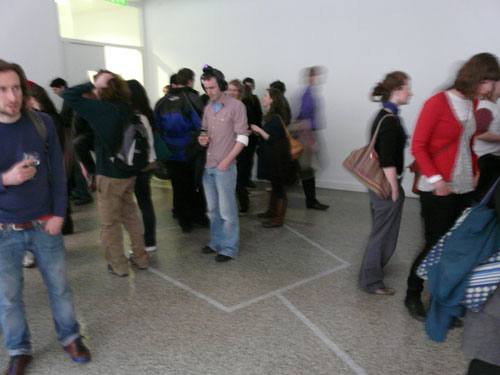 |
Robert Costello: Interactive sound piece; courtesy the artist |
It’s a pity Sharon Phelan’s piece, Abstract machines, is tucked away as it is; at first glance you’d imagine it’s part of the wiring for Costello’s work, as that’s what it is: wiring. Bare light sensors are connected up to tiny speakers, creating a faint chirping sound very similar to that of the bridge on the original Star Trek. You can imagine the artist taking great satisfaction in the fact that her piece involves pure wiring and no computer middleman, yet unfortunately it is difficult to appreciate the piece, surrounded as it is by sound of a less subtle nature. Phelan’s piece would really need to fill the place – rather than be tucked away in the only corner I’ve ever seen in the centre of a room – in order for it to work in this context. However, she will be graduating from NCAD this year, so we should be hopeful that her work gets more of a chance to shine there than it has here.
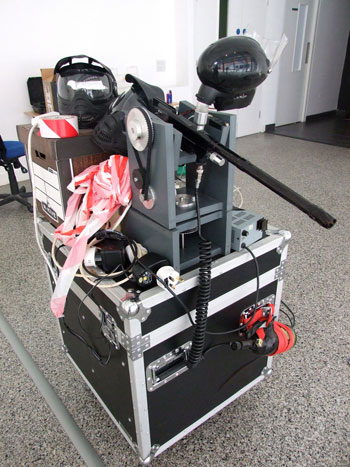 |
Benjamin Gaulon: Graffitti Robot, 2005; courtesy the artist |
The two other pieces in the main area are Benjamin Gaulon’s Graffiti robot and Tim Lloyd’s video piece, On your marks. Gaulon’s work, a computer which programs a robotic paintball gun to fire at the windows of the gallery, is an impressive piece of kit, but beyond that you have to wonder what is the point of having it in a gallery? On the opening night he demonstrated the machine in action against the one clean window remaining, and the performance was widely applauded as well as entertaining, but when a work doesn’t do anything for the rest of the show, and the image it leaves soon degrades into a faded runny mess, what’s the point?
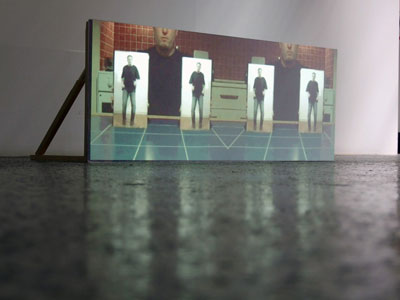 |
Tim Lloyd: On your marks, 2008; courtesy the artist |
If there is a point to the On your marks piece, then it is an exploration of the physicality of the screen. In the piece, which is placed at floor height, Lloyd, in a Gondryesque subterfuge, places his own figure in a frame and proceeds to beat against the edges of it, causing the frame to move. The work is to be lauded for exploring the pseudo physicality of the screen, yet the video itself has all the telltale signs of an idea that has been conceptualised to death. In the piece we see Lloyd sat at a kitchen table holding the frames in his hands as they jump around the table (is this a nod to the notion of desktop media?). Questions such as “Why is the artist featured so prominently in the work?" “Why is it in his hands?" and “Why am I still watching this?" spring to mind, and are not satisfied by the piece alone.
Beyond the main space and in the dark room are works by Jack Phelan and Tim Redfern respectively. Phelan’s Machina mundi is a beautiful-looking object of clockwork aesthetic, which projects small writing and words onto a dark wall. When you put on the headphones you hear the reverberated sound of the machine itself in action, a sound not unlike the sound effects associated with super computers in sixties films such as The Billion-dollar brain . The meaning of the piece itself is somewhat oblique, yet the object is so pulchritudinous it transcends such concerns. If there was some way to combine Graffiti robot with this you’d be very close to having a perfect art object.
 |
Jack Phelan: Machina mundi, 2008; courtesy the artist |
Redfern’s Videogum subtly asks the viewer to interfere with it: “please touch the artwork,” pleads the sign. A turntable that rotates in front of a long-exposure camera creates a pattern, which is then projected live onto a concave curved screen. The objects are an assortment of kitsch items of pop – a garden gnome, a toy windmill, a foil balloon, etc, which the viewer places on the turntable at their leisure. The notion is that it encourages the viewer to reconsider how it is we view forms, especially those familiar to use; a simple change in the method we use to absorb information and our view of the world is distorted. One wonders if (like with George Stratton’s inverted glasses), the brain could adapt to seeing the world this way? Probably not.
One can see Redfern’s justification in choosing pop-culture items: they are familiar and clearly worthless, so people shouldn’t feel afraid to pick them up, chuck them about. The problem is, they aren’t really that interesting as objects – they’re the kind of form we are used to seeing deconstructed via the medium of the refuse bag; we all know what a smashed garden gnome looks like; we all know what a deflated balloon looks like; and we’ve all at some stage witnessed various comedic geniuses carrying around traffic cones at three in the morning, smugly confident of their anarchic credentials as if they’d just kidnapped a politician’s daughter.
There is an entire sub-genre of videos on the internet of the physical deconstructing of objects such as these, and though it’s safe to assume Redfern would not view these investigations as being relevant to his, it is also safe to assume the viewer who visits the show will be on some level familiar with this; the anarchy of Graffiti robot is sure to subconsciously put this in mind.
Returning to Graffiti robot, perhaps there is a meaning in the impotence of a gun that won’t fire off. The metaphor isn’t Freudian but prevailing. Visit the gallery now and you’ll have missed the event; when, in the current age of the consumer / broadcaster it is nigh impossible not to miss the event. Here the event is petrified, it sits on a precipice. Graffiti robot has been widely exhibited, so you can look it up right now and see it in action, but to what degree is the action of doing that akin to pushing it over the precipice . There is a stoic charm to it all. Alongside Redfern’s Videogum, it suffers somewhat in this context by being too stoic; your brain is a little overheated by the time you get to the piece; it needs to cool down. Redfern is listed as being concerned with a “minimalistic aesthetic," yet in the choice of object perhaps the piece isn’t quite minimalist enough; this is unfortunate as the technology itself once again transcends the risk of being a tech demo, but it just seems as though Redfern, on seeing the work he was partnered with, opted to do the artistic equivalent of the teacher putting on a loud shirt in order to look trendy at the school disco.
For the show as a whole, it is the ‘transigence’ of the technology on display which makes it so interesting, and it is to be highly recommended. There is a very definite subculture within the art scene of Dublin currently – quality new-media art, produced by intelligent little whippersnappers (an impressive percentage of which has emerged from the Media Fine Art course in NCAD), and perhaps outside of events such as Darklight, DATA, and the mixed bag that is the art college MA and degree shows, The Garden of digital lies will probably your best opportunity to see a complete picture of it, in Dublin, this year.
Seanán Oliver Manfred Kerr is an artist / writer.